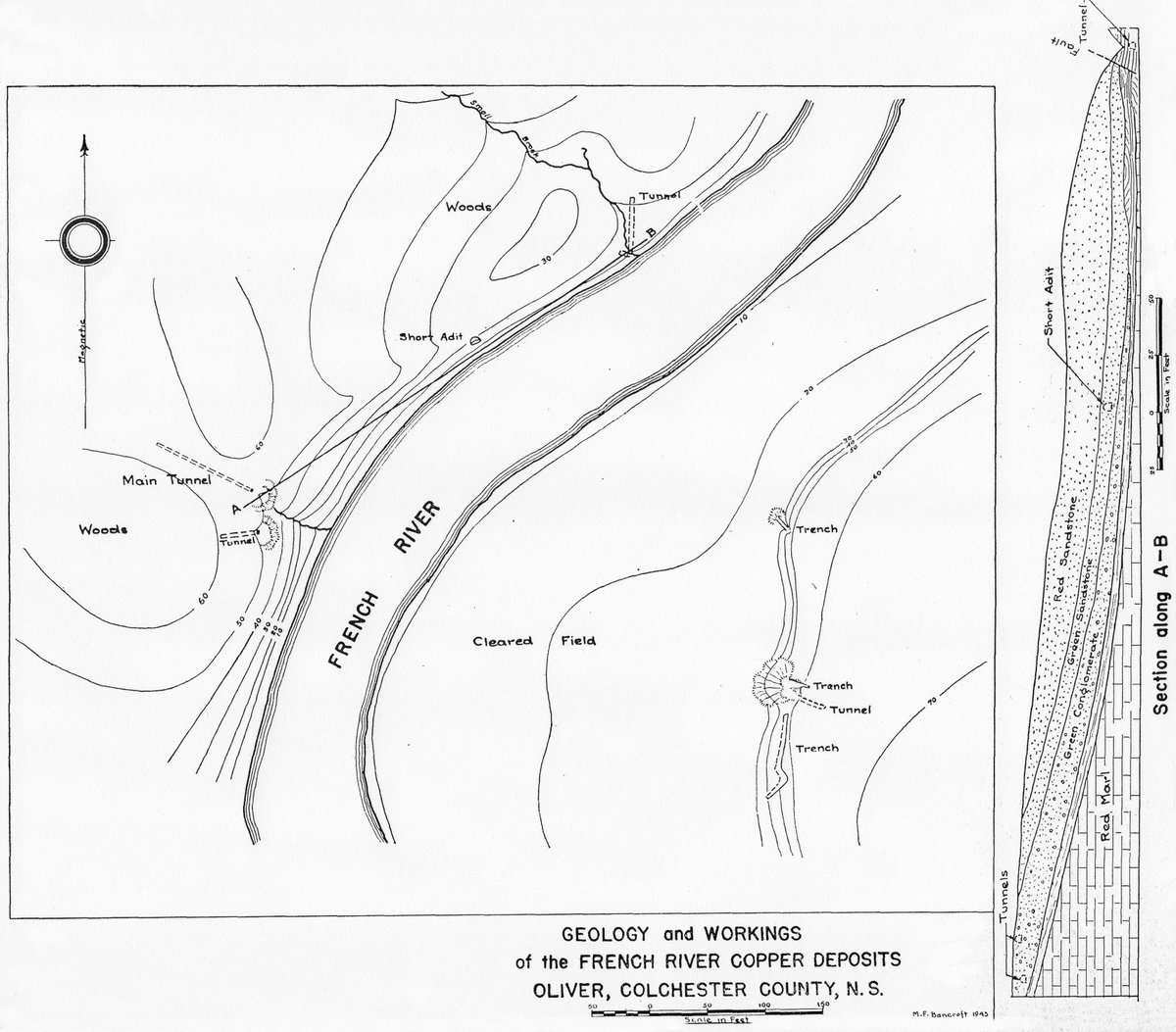We love getting questions about mining, minerals and geology! We were asked about historical copper mining around the #WaughsRiver in Tatamagouche, #CumberlandCounty. See this thread!
#nspoli #cbpoli #novascotia #capebreton
@MLAElizabethNS @SeanFraserMP @Cumberland_NS @ZannLenore

#nspoli #cbpoli #novascotia #capebreton
@MLAElizabethNS @SeanFraserMP @Cumberland_NS @ZannLenore


There are a number of copper occurrences around #WaughsRiver but only a modest amount of actual mining took place.
After their arrival in #Tatamagouche by 1710, the #Acadians attempted smelting small quantities of copper they found around the North Shore, but with little success.
After their arrival in #Tatamagouche by 1710, the #Acadians attempted smelting small quantities of copper they found around the North Shore, but with little success.

For example, they had a small #copper mine on Mine Hole Brook, where it joined with #WaughsRiver from the west (close to where Black River joins the Waugh from the east).
#nspoli #cbpoli #novascotia #capebreton
#nspoli #cbpoli #novascotia #capebreton

Later settlers believed the sharp turn in the Waugh there was an unnatural one caused by the river overflowing into the mine, and that water covered the original workings.
Mining tools and partly-smelted copper ore from the Acadian period were later found in an adjacent field.
Mining tools and partly-smelted copper ore from the Acadian period were later found in an adjacent field.

The potential for copper under the water attracted interest in the mid-1860s and the mining rights were bought by Cullen Ayer of Boston. He sold the property in 1867 to the Boston Mining Association, making an impressive profit - he paid $2,000 and received $35,000.
#nspoli
#nspoli

The Boston Mining Association reportedly diverted the water to its natural course to uncover the old workings and enough ore was extracted to load a 100-ton schooner. Unfortunately, it didn’t last and the mine was again flooded.
#nspoli #cbpoli #novascotia #capebreton
#nspoli #cbpoli #novascotia #capebreton

The bad luck continued: the schooner ran aground and was trapped in ice off Steele's Island (near #Tatamagouche). Not long after, the ship burned and the crew escaped to the island. Locals believed the crew lit the fire to avoid having to spend the winter on the ship.
#nspoli
#nspoli

Years later lumps of the ore, half-smelted by the fire, were salvaged along the shore by the Stirling Mining Company.
There was also a mine in Oliver on the French River, west of #WaughsRiver.
#nspoli #cbpoli #novascotia #capebreton
There was also a mine in Oliver on the French River, west of #WaughsRiver.
#nspoli #cbpoli #novascotia #capebreton

In 1857 Abraham Patterson got a 30 year lease for the property but only extracted a sample to send to England. The property was then idle until 1866 when shallow drifts were sunk on the north-west side of the river.
#nspoli #cbpoli #novascotia #capebreton
#nspoli #cbpoli #novascotia #capebreton

Work stalled again until 1876-77 when six months work by twelve men produced about 36 casks of ore, each averaging about 900 pounds each, or a total of 18.5 tons. The ore was valued in New York at $120.00 per ton. The mine was then abandoned.
#nspoli #cbpoli #novascotia
#nspoli #cbpoli #novascotia

In 1905, the Sterling Mining Company worked on Black River, not far from Mine Hole Brook. By 1907, an estimated 650 tons of ore was mined and 240 tons were shipped to the United States in 1908.
#nspoli #cbpoli #novascotia #capebreton
#nspoli #cbpoli #novascotia #capebreton

On the north side of Woodlock Brook, one mile southeast of Tatamagouche Station, trenches and a 50-foot prospecting tunnel were dug to investigate the site’s potential but no actual mining took place.
#nspoli #cbpoli #novascotia #capebreton
#nspoli #cbpoli #novascotia #capebreton

There are also copper occurrences at the mouth of the French River, Falls Bridge (near Balmoral Mills), Balmoral Brook, Bailey Brook, at the junction of the Yellow Brook and the Waugh River and Balfron (where a little historical extraction took place).
#nspoli #cbpoli #novascotia
#nspoli #cbpoli #novascotia

Calling a site an “occurrence” means a mineral has been found but there is either very little of it or exploration has not shown there to be a significant quantity of it.
It’s also important to note that many historical mines were not mines in the sense that we use the word now.
It’s also important to note that many historical mines were not mines in the sense that we use the word now.

They were often pits just a couple feet deep, or a small shaft or two, often even without a mill for processing. There was often very little actual mining or production in historical mines.
#nspoli #cbpoli #novascotia #capebreton
#nspoli #cbpoli #novascotia #capebreton

The name #Tatamagouche is derived from the #Mikmaq term “Takumegooch” which means, roughly translated, “meeting of the waters,” because it's where the Waugh and French Rivers run into a harbour.
#nspoli #cbpoli #novascotia #capebreton

#nspoli #cbpoli #novascotia #capebreton


• • •
Missing some Tweet in this thread? You can try to
force a refresh



























